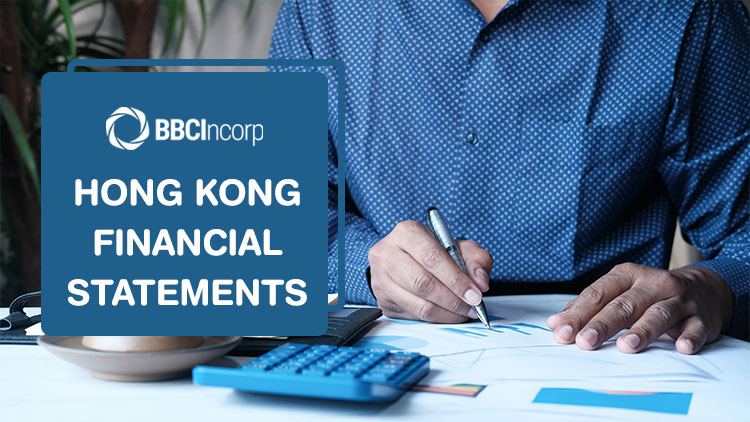
If you incorporate a company in Hong Kong, you’ll need to prepare and maintain financial statements on an annual basis.
A financial statement gives you a clearer view of your business spending. It also serves as a company’s credentials that help you attract potential investors and secure your business loan.
Whether you work with an accountant or manage your own accounts, it’s important to know the basic concepts.
Let’s dive into the key factors of Hong Kong financial statements. So by the end of this article, you’ll understand the general requirements, determine your reporting exemption, and handle your statements confidently.
Keep reading to find out!
1. What is a Hong Kong company financial statement?
Generally, a financial statement (FS) is the report card of your business. It presents the financial performance of your company.

You’ll need to submit your financial statement for an audit. So, make sure you choose a Hong Kong government agencies are to ensure credibility.
What’s the main purpose?
The main purpose of a financial statement is to demonstrate your company’s financial condition.
Also, you can use it to analyze the company’s performance and make predictions about the future direction.
For instance, you run a clothing business in Hong Kong and plan to open a chain of stores in different locations.
You can look at the financial statement to check your annual income. After that, you can work out how much money you’ll need to cover extra costs for your store chains.
Besides, investors also rely on the data of FS to see your company’s financial health and earning potential.
If your statement shows a profit, it means you’re more likely to receive partnership opportunities or get more investors on board.
Apart from financial statements, there are other Hong Kong Company Annual Compliance Requirements you need to fulfill. Click away to uncover proven tips and tactics!
2. What’s included in Hong Kong company financial statements?
Generally, financial statements in Hong Kong include three main components, including the income statement, balance sheet, and cash flow statement.

Read on to find out what information you need to provide for each area.
2.1. The Income Statement
This statement focuses on four areas – revenue, gains, expense, and losses.
- Revenue
The revenue includes operating revenue and non-operating revenue.
Basically, if your company sells products or services, the earnings from these activities are operating revenue.
If your earnings are from secondary, non-core business activities (e.g. bank interest, rental, royalty payment, etc.), you’ll list them down under non-operating revenue.
- Gains
The gains state your net money from other activities, like the sale of long-term assets.
For instance, if your company sells an old transportation van, unused land, or a warehouse, these transactions will appear in the gains section.
- Expenses
In general, your company expenses are divided into primary expenses and secondary expenses.
The primary expense links to the operation of your business activities.
For example, wages, sales commissions, or electricity bills, are primary expenses.
Conversely, secondary expenses link to non-core business activities, like interest paid on loan money.
- Losses
In summary, the losses section shows the money goes towards a loss-making sale of long-term assets or any other unusual costs.
Let’s say your company is involved in a civil lawsuit. The costs for compensation will be recorded as losses in the income statement.
Note
The primary revenue and expenses provide an understanding of your company’s core business performance.
On the other hand, the secondary factors show how well you utilize resources for additional profitability and minimize operational risks.
2.2. The Balance Sheet
The balance sheet reports your company’s assets, liabilities, and shareholder equity at a specific point in time.
- Assets
You need to divide your assets into current assets and non-current assets, depending on their liquidity level.
Your current assets include liquidating items such as cash, securities, accounts receivable, inventor, etc.
Your non-current assets consist of fixed properties (e.g. land, machinery, buildings) and non-physical properties (e.g. intellectual property, goodwill).
- Liabilities
Basically, liability refers to the money you owe to outside parties.
For example, supplier bills, bank interest, rent, utilities, and salaries are company liabilities.
Your company liabilities are also categorized into current (e.g. rent, utilities, salaries) and non-current (e.g. bank interest, taxes)
- Shareholder equity
This section shows the remaining amount of assets available to shareholders after you pay your debts and liabilities.
It’s calculated by taking the total assets minus total liabilities (Total Assets – Total Liabilities)
If the result is negative, you’ve used all your assets to pay debts. Thus, you’ll have nothing left to pay your shareholders.
In contrast, if shareholder equity is positive, your company’s assets exceed the liabilities. This means your shareholders are likely to get a return on their investment.
Quick tip
Your assets should always equal your liabilities and shareholder equity. This means your balance sheet should always balance, hence the name.
If they don’t balance, there may be some incorrect data, errors, or miscalculations.
2.3. The Cash Flow Statement (CFS)
This statement summarizes the amount of cash entering and leaving your company.
The CFS is important since it determines your cash position. This helps you predict your budgeting matters.
The three main components of the CFS are:
- Cash from operating activities shows the amount of cash from your products or services.
It reflects the strength of your core business activities.
For example, cash from your sale of goods (revenue) or from payment to suppliers (expense).
- Cash from investing activities displays cash activities from your investment.
These can be the sales of land, purchase property and equipment.
- Cash from financing activities covers cash activities from liabilities and equity financing (e.g. dividends to shareholders, loan repayments).
Note that a negative cash flow could be the result of a business expansion or new product development at a certain time point.
Thus, you should always look at CFS in unison with the other two statements.
As a director, you probably have a million tasks and deadlines to handle. And producing a financial statement is just another thing on your endless to-do list.
We’ve got you covered! Our Accounting Service provides logistical support that lifts the burden off your shoulders. So you can have professional-looking financial statements without taking time out of your busy day.
3. What are the requirements for financial statements in Hong Kong?
Let’s discuss the basic concepts and a list of requirements that you need to fulfill for your financial statement.

3.1. Accounts and records keeping
You need to maintain proper records and accounts to comply with Hong Kong regulations on an annual basis, which may include bank statements, expenses, and sales receipts.
This practice helps you make sure all financial transactions are correct and up to date.
Once you align all your accounts and records, you can start preparing your financial statements.
3.2. Meeting general requirements
As a company’s director, you’ll need to prepare financial statements for each financial year-end.
Particularly, your FS should meet the below requirements:
- giving a true and fair view of the financial position, unless your company falls within the reporting exemption
- complying with the Hong Kong Financial Reporting Standards (HKFRS) issued by the Hong Kong Institute of Certified Public Accountants (HKICPA)
- audited by an auditor licensed as a Hong Kong Certified Public Accountant (CPA)
3.3. Choosing financial year-end
To properly prepare your financial statements, you should determine your financial year-end (FYE).
Your Hong Kong company’s first financial year-end date should be picked by the direct board. And it must fall within 18 months after your incorporation date.
For the following financial years, your year-end date will be on the anniversary of such specified date.
Let’s say your incorporation date is 1 May 2020. You can choose your first year-end date as 31 December 2020 (within 18 months from incorporation date). Then for the following years, your FYE date is 31 December.
Common financial year-end dates in Hong Kong include 31 December, 31 March, 30 June, and 30 September.
It’s not just you – choosing a financial year-end could be a brutal process for many entrepreneurs. The good news? Our exclusive guideline will make picking your Hong Kong financial year-end so much easier.
4. Which companies are eligible for reporting exemptions?
According to Companies Ordinance (Amendment No.2) 2018, you can be eligible for reporting exemptions of financial statements.
4.1. What’s a reporting exemption?
A reporting exemption does not mean you can abandon your financial statement.
You’ll still need to fully prepare your statements. But the contents of those statements will be simpler in the following ways:
- no requirement to give a true and fair view;
- no requirements to disclose certain transactions involving the directors and the company; and
- adopt the “Small and Medium-sized Entity Financial Reporting Framework and Financial Reporting Standard” with fewer requirements (i.e. no cash flow statement) and disclosures (i.e. no disclosure of financial risk management strategies).
4.2. How can you be eligible for exemption?
You can take advantage of the reporting exemption in Hong Kong. Provided that your company is a private company or a company limited by guarantee, and it satisfies certain requirements.
Specifically, your company needs to meet 2 out of 3 criteria of the size test to get a reporting exemption.
The size test criteria include annual revenue, total asset, and the number of employees.
- As a small private company
-
- no more than HK$100 million in annual revenue
-
- no more than HK$100 million in total assets
-
- the number of employees not exceeding 100
- As a company limited by guarantee: not exceeding HK$25 million in total annual revenue.
For a full list of criteria for Hong Kong reporting exemption, head over to our related article.
4.3. Should you adopt reporting exemptions?
The reporting exemption is optional. You can prepare your financial statements in a full reporting regime as you wish.
Or, you can switch to the simplified regime at any time in the future, if you’re eligible.
It’s important that you weigh up the pros and cons carefully before changing your regime.
Let’s say you’re the sole owner of your Hong Kong business. This means no one else other than the tax authorities will see your financial statements. Thus, a simple regime will help you reduce the reporting complexity
But if other people also use your financial statements. Let’s say your shareholders, investors, or customers. Then producing full financial statements may prove more useful.
5. Key Takeaways
To summarize, let us list some notable points for you to consider!
Key takeaways
- The Financial Statement reflects the financial position and performance of your company
- A financial statement includes three main components – the income statement, the balance sheet, and the cash flow statement
- To prepare your company’s financial statements, you’ll need to:
(1) maintain accounts and records;
(2) meet the general requirements; and
(3) choose a financial year-end date.
- Your company could be eligible for reporting exemption if meeting certain criteria. Reporting exemption is s a simplified regime for financial statements.
If you want to complete your reporting compliance in effective ways, you can always rely on our skillful team for a stress-free experience.
Drop a message or get in touch with one of our friendly consultants for actionable advice!
Disclaimer: While BBCIncorp strives to make the information on this website as timely and accurate as possible, the information itself is for reference purposes only. You should not substitute the information provided in this article for competent legal advice. Feel free to contact BBCIncorp’s customer services for advice on your specific cases.
Get helpful tips and info from our newsletter!
Stay in the know and be empowered with our strategic how-tos, resources, and guidelines.


